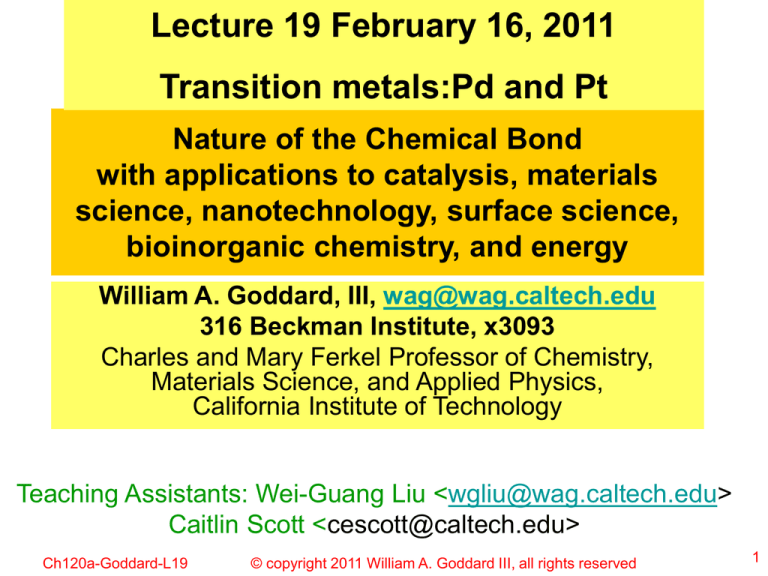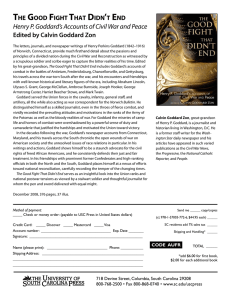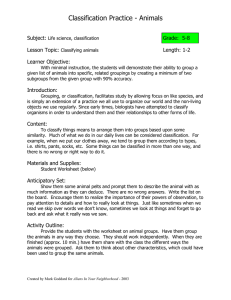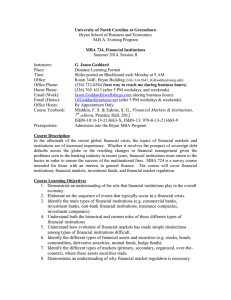
Lecture 19 February 16, 2011
Transition metals:Pd and Pt
Nature of the Chemical Bond
with applications to catalysis, materials
science, nanotechnology, surface science,
bioinorganic chemistry, and energy
William A. Goddard, III, wag@wag.caltech.edu
316 Beckman Institute, x3093
Charles and Mary Ferkel Professor of Chemistry,
Materials Science, and Applied Physics,
California Institute of Technology
Teaching Assistants: Wei-Guang Liu <wgliu@wag.caltech.edu>
Caitlin Scott <cescott@caltech.edu>
Ch120a-Goddard-L19
© copyright 2011 William A. Goddard III, all rights reserved
1
Last time
Ch120a-Goddard-L19
© copyright 2011 William A. Goddard III, all rights reserved
2
Compare chemistry of column 10
Ch120a-Goddard-L19
© copyright 2011 William A. Goddard III, all rights reserved
3
Ground state of group 10 column
Pt: (5d)9(6s)1 3D ground state
Pt: (5d)10(6s)0 1S excited state at 11.0 kcal/mol
Pt: (5d)8(6s)2 3F excited state at 14.7 kcal/mol
Ni: (5d)8(6s)2 3F ground state
Ni: (5d)9(6s)1 3D excited state at
0.7 kcal/mol
Ni: (5d)10(6s)0 1S excited state
at 40.0 kcal/mol
Pd: (5d)10(6s)0 1S ground state
Pd: (5d)9(6s)1 3D excited state at 21.9 kcal/mol
Pd:Ch120a-Goddard-L19
(5d)8(6s)2 3F excited
state
atWilliam
77.9A. Goddard
kcal/mol
© copyright
2011
III, all rights reserved
4
Salient differences between Ni, Pd, Pt
Ni
Pd
Pt
2nd row (Pd): 4d much more stable than 5s Pd d10 ground state
3rd row (Pt): 5d and 6s comparable stability Pt d9s1 ground state
5s much less stable than 4d 6s, 5d similar stability
Differential shielding favors Relativistic effects of 1s
3d much smaller than 4s
n=4 over n=5,
(No 3d Pauli orthogonality)
huge decreased KE
10
stabilize 4d over 5s d
Huge e-e repulsion for d10
contraction stabilize
4d similar size to 5s
and contract all ns
5
Ch120a-Goddard-L19
© copyright
2011
reservedand expand nd
(orthog
to William
3d,4s A. Goddard III, all rights
destabilize
4s more stable than 3d
Mysteries from experiments on oxidative addition and reductive
elimination of CH and CC bonds on Pd and Pt
Why is CC coupling
so much harder than CH coupling?
© copyright 2011 William A. Goddard III, all rights reserved
Ch120a-Goddard-L19
6
Step 1: examine GVB orbitals for (PH3)2Pt(CH3)
Ch120a-Goddard-L19
© copyright 2011 William A. Goddard III, all rights reserved
7
Analysis of GVB wavefunction
Ch120a-Goddard-L19
© copyright 2011 William A. Goddard III, all rights reserved
8
Alternative models for Pt centers
Ch120a-Goddard-L19
© copyright 2011 William A. Goddard III, all rights reserved
9
Ch120a-Goddard-L19
© copyright 2011 William A. Goddard III, all rights reserved
10
energetics
Ch120a-Goddard-L19
Not agree with
experiment 11
© copyright 2011 William A. Goddard III, all rights reserved
Possible explanation: kinetics
Ch120a-Goddard-L19
© copyright 2011 William A. Goddard III, all rights reserved
12
Consider reductive elimination of HH,
CH and CC from Pd
Conclusion:
HH no barrier
CH modest barrier
CC large barrier
Ch120a-Goddard-L19
© copyright 2011 William A. Goddard III, all rights reserved
13
Consider oxidative addition of
HH, CH, and CC to Pt
Ch120a-Goddard-L19
Conclusion:
HH no barrier
CH modest barrier
CCreserved
large barrier 14
© copyright 2011 William A. Goddard III, all rights
Summary of barriers
This explains why CC coupling not occur for Pt while CH
and HHcoupling is fast
But why?
Ch120a-Goddard-L19
© copyright 2011 William A. Goddard III, all rights reserved
15
How estimate the size of barriers (without calculations)
Ch120a-Goddard-L19
© copyright 2011 William A. Goddard III, all rights reserved
16
Examine HH coupling at transition state
Can simultaneously get good overlap of H with Pd sd
hybrid and with the other H
Thus get resonance stabilization of TS low barrier
Ch120a-Goddard-L19
© copyright 2011 William A. Goddard III, all rights reserved
17
Examine CC coupling at transition state
Can orient the CH3 to obtain good overlap with Pd sd hybrid OR
can orient the CH3 to obtain get good overlap with the other CH3
But CANNOT DO BOTH SIMULTANEOUSLY, thus do NOT get
18
resonance© stabilization
ofA. TS
III,high
barier
Ch120a-Goddard-L19
copyright 2011 William
Goddard
all rights
reserved
Examine CH coupling at transition state
Ch120a-Goddard-L19
H can overlap
both CH3 and Pd
sd hybrid
simultaneously
but CH3 cannot
thus get ~ ½
resonance
stabilization of TS
19
© copyright 2011 William A. Goddard III, all rights reserved
Now we understand Pt chemistry
But what about Pd?
Why are Pt and Pd so
dramatically different
Ch120a-Goddard-L19
© copyright 2011 William A. Goddard III, all rights reserved
20
new
Ch120a-Goddard-L19
© copyright 2011 William A. Goddard III, all rights reserved
21
Pt goes from s1d9 to d10 upon reductive elimination
thus product stability is DECREASED by 12 kcal/mol
Using numbers
from QM
Ch120a-Goddard-L19
© copyright 2011 William A. Goddard III, all rights reserved
22
Pd goes from s1d9 to d10 upon reductive elimination
thus product stability is INCREASED by 20 kcal/mol
Using numbers
from QM
Pd and Pt would be ~ same
Ch120a-Goddard-L19
© copyright 2011 William A. Goddard III, all rights reserved
23
Thus reductive elimination from Pd is stabilized by an extra 32
kcal/mol than for Pt due to the ATOMIC nature of the states
The dramatic stabilization of the product by 35 kcal/mol
reduces the barrier from ~ 41 (Pt) to ~ 10 (Pd)
This converts a forbidden reaction to allowed
Ch120a-Goddard-L19
© copyright 2011 William A. Goddard III, all rights reserved
24
Summary energetics
Conclusion the atomic
character of the metal can
control the chemistry
Ch120a-Goddard-L19
© copyright 2011 William A. Goddard III, all rights reserved
25
Examine bonding to all three rows of transition metals
Use MH+ as model because a positive metal is more
representative of organometallic and inorganic complexes
M0 usually has two electrons in ns orbitals or else one
M+ generally has one electron in ns orbitals or else zero
M2+ never has electrons in ns orbitals
Ch120a-Goddard-L19
© copyright 2011 William A. Goddard III, all rights reserved
26
Ground states of neutral atoms
Sc
(4s)2(3d)
Sc+
(4s)1(3d)1
Ti
(4s)2(3d)2
Ti+
(4s)1(3d)2
V
(4s)2(3d)3
V+
(4s)0(3d)3
Cr
(4s)1(3d)5
Cr+
(4s)0(3d)5
Mn
(4s)2(3d)5
Mn+
(4s)1(3d)5
Fe
(4s)2(3d)6
Fe+
(4s)1(3d)6
Co
(4s)2(3d)7
Co+
(4s)0(3d)7
Ni
(4s)2(3d)8
Ni+
(4s)0(3d)8
Cu
(4s)1(3d)10 Cu+
Ch120a-Goddard-L19
(4s)0(3d)10
Sc++
Ti ++
V ++
Cr ++
Mn ++
Fe ++
Co ++
Ni ++
Cu++
© copyright 2011 William A. Goddard III, all rights reserved
(3d)1
(3d)2
(3d)3
(3d)4
(3d)5
(3d)6
(3d)7
(3d)8
(3d)10
27
Bond energies MH+
Re
Mo
Au
Cr
Cu
Ag
Ch120a-Goddard-L19
© copyright 2011 William A. Goddard III, all rights reserved
28
Exchange energies:
Mn+: s1d5
For high spin (S=3)
A[(d1a)(d2a)(d3a)(d4a)(d5a)(sa)]
Get 6*5/2=15 exchange terms
5Ksd + 10 Kdd
Responsible for Hund’s rule
Ksd Kdd
Mn+ 4.8
19.8 kcal/mol
Tc+ 8.3
15.3
Re+ 11.9 14.1
Form bond to H, must lose half
the exchange stabilization for
the orbital bonded to the H
A{(d1a)(d2a)(d3a)(d4a)(sdba)[(sdb)H+H(sdb)](ab-ba)}
sdb is a half the time and b half the time
Ch120a-Goddard-L19
© copyright 2011 William A. Goddard III, all rights reserved
29
Ground state of M+ metals
Mostly s1dn-1
Exceptions:
1st row: V, Cr-Cu
2nd row: Nb-Mo, Ru-Ag
3rd row: La, Pt, Au
Ch120a-Goddard-L19
© copyright 2011 William A. Goddard III, all rights reserved
30
Size of atomic orbitals, M+
Valence s similar for all
three rows,
5s biggest
Big decrease from
La(an 57) to Hf(an 72
Valence d very small
for 3d
Ch120a-Goddard-L19
© copyright 2011 William A. Goddard III, all rights reserved
31
Charge transfer in MH+ bonds
electropositive
1st row all
electropositive
2nd row:
Ru,Rh,Pd
electronegative
3rd row:
Pt, Au, Hg
electronegative
electronegative
Ch120a-Goddard-L19
© copyright 2011 William A. Goddard III, all rights reserved
32
Ch120a-Goddard-L19
© copyright 2011 William A. Goddard III, all rights reserved
33
Ch120a-Goddard-L19
© copyright 2011 William A. Goddard III, all rights reserved
34
Ch120a-Goddard-L19
© copyright 2011 William A. Goddard III, all rights reserved
35
Ch120a-Goddard-L19
© copyright 2011 William A. Goddard III, all rights reserved
36
1st row
Ch120a-Goddard-L19
© copyright 2011 William A. Goddard III, all rights reserved
37
Ch120a-Goddard-L19
© copyright 2011 William A. Goddard III, all rights reserved
38
Schilling
Ch120a-Goddard-L19
© copyright 2011 William A. Goddard III, all rights reserved
39
Steigerwald
Ch120a-Goddard-L19
© copyright 2011 William A. Goddard III, all rights reserved
40
Ch120a-Goddard-L19
© copyright 2011 William A. Goddard III, all rights reserved
41
Ch120a-Goddard-L19
© copyright 2011 William A. Goddard III, all rights reserved
42
2nd row
Ch120a-Goddard-L19
© copyright 2011 William A. Goddard III, all rights reserved
43
Ch120a-Goddard-L19
© copyright 2011 William A. Goddard III, all rights reserved
44
Ch120a-Goddard-L19
© copyright 2011 William A. Goddard III, all rights reserved
45
Ch120a-Goddard-L19
© copyright 2011 William A. Goddard III, all rights reserved
46
Ch120a-Goddard-L19
© copyright 2011 William A. Goddard III, all rights reserved
47
Ch120a-Goddard-L19
© copyright 2011 William A. Goddard III, all rights reserved
48
Ch120a-Goddard-L19
© copyright 2011 William A. Goddard III, all rights reserved
49
3rd row
Ch120a-Goddard-L19
© copyright 2011 William A. Goddard III, all rights reserved
50
Ch120a-Goddard-L19
© copyright 2011 William A. Goddard III, all rights reserved
51
Ch120a-Goddard-L19
© copyright 2011 William A. Goddard III, all rights reserved
52
Ch120a-Goddard-L19
© copyright 2011 William A. Goddard III, all rights reserved
53
Ch120a-Goddard-L19
© copyright 2011 William A. Goddard III, all rights reserved
54
Ch120a-Goddard-L19
© copyright 2011 William A. Goddard III, all rights reserved
55
Ch120a-Goddard-L19
© copyright 2011 William A. Goddard III, all rights reserved
56
Ch120a-Goddard-L19
© copyright 2011 William A. Goddard III, all rights reserved
57
Ch120a-Goddard-L19
© copyright 2011 William A. Goddard III, all rights reserved
58
Ch120a-Goddard-L19
© copyright 2011 William A. Goddard III, all rights reserved
59
Ch120a-Goddard-L19
© copyright 2011 William A. Goddard III, all rights reserved
60
Ch120a-Goddard-L19
© copyright 2011 William A. Goddard III, all rights reserved
61
Ch120a-Goddard-L19
© copyright 2011 William A. Goddard III, all rights reserved
62
Physics behind Woodward-Hoffman Rules
For a reaction to be allowed, the number of bonds must be
conserved. Consider H2 + D2
2 bonds
TS ? bonds
2 bonds
To be allowed must have 2 bonds at TS
How assess number of bonds at the TS. What do the
dots mean? Consider first the fragment
Have 3 electrons, 3 MO’s
Have 1 bond. Next
consider 4th atom, can
nonbonding
Bonding
antibonding
we Ch120a-Goddard-L19
get 2 bonds?
1 elect
2 2011
elect
© copyright
William A. Goddard
III, all rights reserved 0 elect 63
Can we have 2s + 2s reactions for transition
metals?
2s + 2s forbidden for organics
X
2s + 2s forbidden for organometallics?
?
Cl2Ti
Cl2Ti
Me
Me
Ch120a-Goddard-L19
Cl2Ti
Cl2Ti
Me
?
Me
Cl2Ti
Cl2Ti
Me
© copyright 2011 William A. Goddard III, all rights reserved
Me
64
Physics behind Woodward-Hoffman Rules
Bonding
2 elect
nonbonding
1 elect
antibonding
0 elect
Have 1 bond. Question, when add 4th atom, can we get 2 bonds?
Can it bond to the nonbonding orbital?
Answer: NO. The two orbitals are orthogonal in the TS, thus the
reaction is forbidden
65
Ch120a-Goddard-L19
© copyright 2011 William A. Goddard III, all rights reserved
Now consider a TM case: Cl2TiH+ + D2
Orbitals of reactants
GVB orbitals
of TiH bond
for Cl2TiH+
GVB orbitals
of D2
Ch120a-Goddard-L19
© copyright 2011 William A. Goddard III, all rights reserved
66
Is Cl2TiH+ + D2 Cl2TiD+ + HD allowed?
Bonding
2 elect
nonbonding
1 elect
antibonding
0 elect
when add Ti 4th atom, can we get 2 bonds?
Now the bonding orbital on Ti is d-like. Thus at TS have
Answer: YES. The two orbitals can have high overlap at the TS
orthogonal
in the TS,©thus
the reaction is allowed
Ch120a-Goddard-L19
copyright 2011 William A. Goddard III, all rights reserved
67
GVB orbitals at the TS for
Cl2TiH+ + D2 Cl2TiD+ + HD
Ch120a-Goddard-L19
© copyright 2011 William A. Goddard III, all rights reserved
68
GVB orbitals for the Cl2TiD+ + HD product
Note get phase change
for both orbitals
Ch120a-Goddard-L19
© copyright 2011 William A. Goddard III, all rights reserved
69
Follow the D2
bond as it
evolves into the
HD bond
Ch120a-Goddard-L19
© copyright 2011 William A. Goddard III, all rights reserved
70
Follow the TiH
bond as it
evolves into the
TiD bond
Ch120a-Goddard-L19
© copyright 2011 William A. Goddard III, all rights reserved
71
Barriers small, thus allowed
Increased d character in
bond smaller barrier
Ch120a-Goddard-L19
© copyright 2011 William A. Goddard III, all rights reserved
72
Are all MH reactions with D2 allowed? No
Example: ClMn-H + D2
Here the Mn-Cl bond is very polar
Mn(4s-4pz) lobe orbital with Cl:3pz
This leaves the Mn: (3d)5(4s+4pz), S=3 state to bond to the H
But spin pairing to a d orbital would lose
4*Kdd/2+Ksd/2= (40+2.5) = 42.5 kcal/mol
whereas bonding to the (4s+4pz) orbital loses
5*Ksd/2 = 12.5 kcal/mol
As a result the H bonds to (4s+4pz), leaving a high spin d5.
Now the exchange reaction is forbidden
Ch120a-Goddard-L19
© copyright 2011 William A. Goddard III, all rights reserved
73
Show reaction for ClMnH + D2
Show example reactions
Ch120a-Goddard-L19
© copyright 2011 William A. Goddard III, all rights reserved
74
Olefin Metathesis
2+2 metal-carbocycle reactions
Diego Benitez, Ekaterina Tkatchouk, Sheng Ding
Ch120a-Goddard-L21
© copyright 2010 William A. Goddard III, all rights reserved
75
OLEFIN METATHESIS
Catalytically make and break double bonds!
R1
R1
+
R2
2
R2
R1
R2
Mechanism: actual catalyst is a metal-alkylidene
R2
M
R1
Ch120a-Goddard-L21
R2
R2
M
M
R3
R1
R3
R1
R3
© copyright 2010 William A. Goddard III, all rights reserved
76
Ru Olefin Metathesis Basics
Ch120a-Goddard-L21
© copyright 2010 William A. Goddard III, all rights reserved
77
Common Olefin Metathesis Catalysts
Ch120a-Goddard-L21
© copyright 2010 William A. Goddard III, all rights reserved
78
Applications of the olefin metathesis reaction
Small scale synthesis
to industrial polymers
Acc. Chem. Res. 2001, 34, 18-29
Ch120a-Goddard-L21
bulletproof resin
http://www.pslc.ws/macrog/pdcpd.htm
79
© copyright 2010 William A. Goddard III,
all rights reserved
History of Olefin Metathesis Catalysts
Ch120a-Goddard-L21
© copyright 2010 William A. Goddard III, all rights reserved
80
Well-defined metathesis catalysts
R
iPr
N
(F3C)2MeCO
Mo
(F3C)2MeCO
Cl PCy3 Ph
Ru
Cl
PCy3
iPr
Ph
CH 3
CH 3
Bazan, G. C.; Oskam, J. H.;
Cho, H. N.; Park, L. Y.;
Schrock, R. R. J. Am.
Chem. Soc. 1991, 113,
6899-6907
Cl
Ru
N Mes
Ph
PCy3
R=H, Cl
2
Grubbs 1991
ruthenium
benzylidene
complexb
1
Schrock 1991
alkoxy imido
molybdenum
complexa
Mes N
Cl
R
Wagener, K. B.;
Boncella, J. M.; Nel,
J. G. Macromolecules
1991, 24, 2649-2657
GODDARD
3
Grubbs 1999
1,3-dimesityl-imidazole-2-ylidenes
P(Cy)3 mixed ligand system”c
Scholl, M.; Trnka, T. M.; Morgan,
J. P.; Grubbs, R. H. Tetrahedron
Lett. 1999, 40, 2247-2250.
Ch120-L20 13/11/02
81
Examples
of Common
Second
Generation
Examples
2nd Generation
Grubbs
Metathesis Grubbs-type
Catalysts
Metathesis Catalysts and Mechanism Overview
Mes N
N Mes
Cl
Mes N
Ru
Cl
PCy3
N Mes
Cl
Mes N
Ru
Cl
Ph
Ru
O
Cl
i-Pr
slow initiating catalyst
N Mes
Cl
fast-initiating catalyst
Py
Ph
ultra-fast-initiating catalyst
General mechanism of Metathesis
IMes
Ru
Cl
Cl
Ph
L
IMes
Cl
Ru
Cl
IMes
Cl
Ru
R3
R1
L
R2
Initiation
R
Cl
IMes
IMes
Cl R
Ru
Cl
R3
R2
Cl
Propagation
Ru
Cl
R3
+
R1
R2
Ch120a-Goddard-L21
© copyright 2010 William A. Goddard III, all rights reserved
82
Schrock and Grubbs catalysts make olefin metathesis practical
Schrock catalyst –
very active, but destroys
many functional groups
Grubbs catalyst –
very stable, high functional
group tolerance, but not as
reactive as Schrock
Catalysts contain many years of evolutionary improvements
Ch120a-Goddard-L21
© copyright 2010 William A. Goddard III, all rights reserved
83




